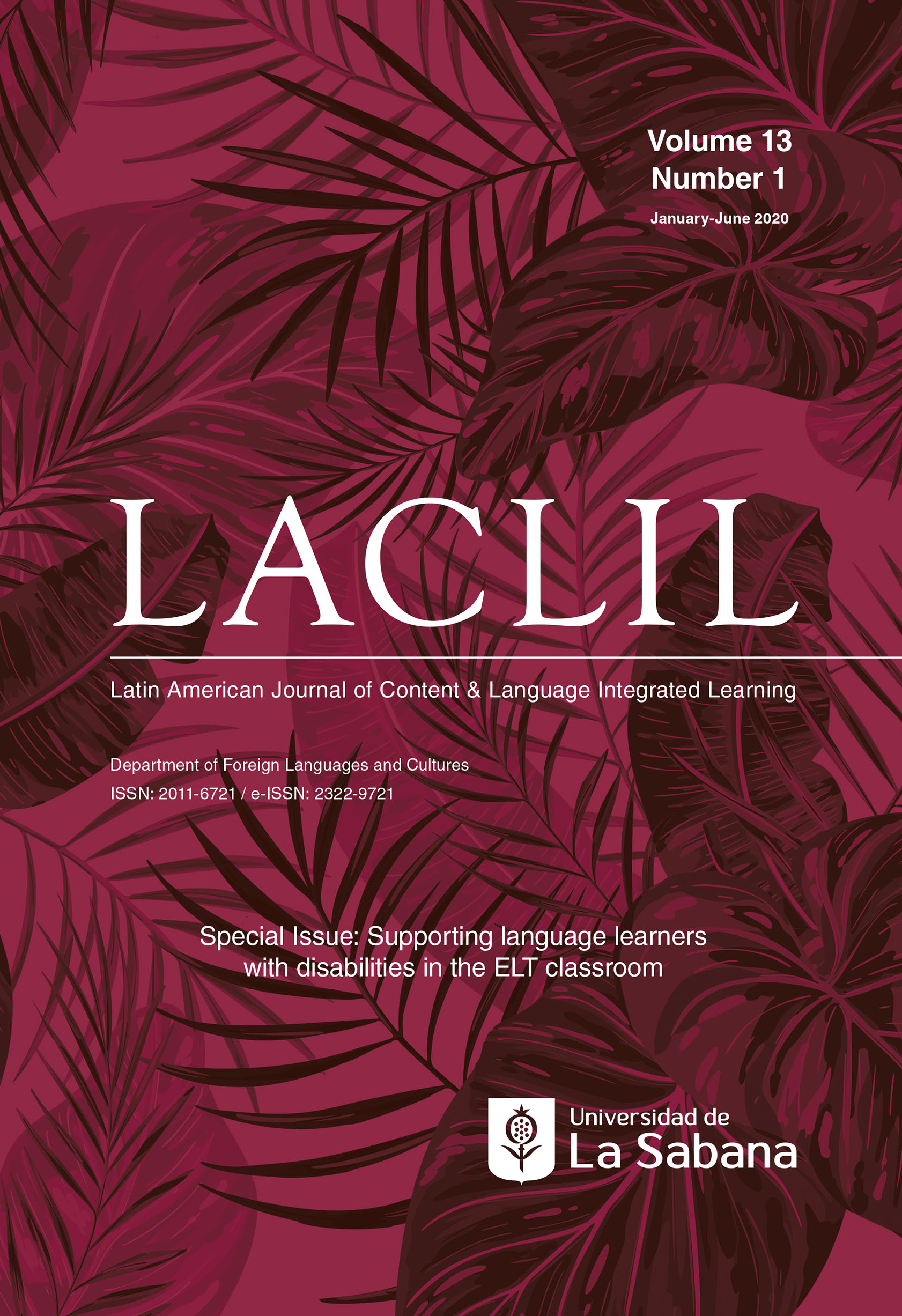Universal Design for Learning in Assessment: Supporting ELLs with Learning Disabilities
DOI:
https://doi.org/10.5294/laclil.2020.13.1.5Palabras clave:
Dificultad en el aprendizaje, diseño universal, diseño universal para el aprendizaje, DUA, valoración, evaluación, enseñanza superior.Resumen
Diseño universal para el aprendizaje en la evaluación: apoyo a los ELL con dificultades de aprendizaje
Design universal para a aprendizagem na avaliação: apoio aos ELLs com dificuldades de aprendizagem
Estudiar inglés es un desafío y, para muchos estudiantes, las discapacidades de aprendizaje no diagnosticadas pueden representar una seria amenaza para su éxito. Los más recientes estudios indican que, hasta un 10 % de la población mundial tiene una discapacidad no aparente, como el autismo o la dislexia. Al mismo tiempo, pocos profesores de aprendices de inglés (ELL) en educación superior han recibido entrenamiento en discapacidades de aprendizaje y, a menudo, no están seguros de cómo apoyar a los alumnos que parecen tener otros desafíos. Esto es particularmente cierto en lo que respecta a la evaluación, ya que los instructores a menudo se basan en herramientas tradicionales que podrían afectar negativamente la validez de los resultados de la evaluación. En esta breve reflexión, los autores comparten cómo los instructores pueden aplicar los principios del Diseño Universal para el Aprendizaje (DUA) a sus prácticas de evaluación para apoyar a los estudiantes con discapacidades, independientemente del estado de diagnóstico. Luego, los autores proporcionarán una descripción general de la teoría DUA, que propone que los estudiantes con discapacidades a menudo se benefician más con adaptaciones en representación, expresión y participación que pueden beneficiar a toda la clase. La mayor parte del artículo se centrará en estrategias prácticas específicas para implementar la DUA dentro de la evaluación en la educación superior. Dichas estrategias incluyen desarrollar la función ejecutiva, implementar evaluaciones multicanal y aprender sobre los estudiantes a través de un “ciclo de evaluación”.
To reference this article (APA) / Para citar este artículo (APA) / Para citar este artigo (APA)
Delaney, T. A., & Hata, M. (2020). Universal design for learning in assessment: Supporting ELLs with learning disabilities. Latin American Journal of Content & Language Integrated Learning, 13(1), 79-91. https://doi.org/10.5294/laclil.2020.13.1.5
Received: 16/10/2019
Accepted: 25/02/2020
Published: 28/08/2020
Descargas
Citas
American Psychiatric Association. (2019a). What is ADHD? https://www.psychiatry.org/patients-families/adhd/what-is-adhd
American Psychiatric Association. (2019b). What is autism spectrum disorder? https://www.psychiatry.org/patients-families/autism/what-is-autism-spectrum-disorder
Brookhart, S. M. (2009). The many meanings of “multiple measures.” Educational Leadership, 67(3), 6–12. http://www.ascd.org/publications/educational-leadership/nov09/vol67/num03/The-Many-Meanings-of-%C2%A3Multiple-Measures%C2%A3.aspx
Butterworth, B., & Kovas, Y. (2013). Understanding neurocognitive developmental disorders can improve education for all. Science, 340(6130), 300–305. https://doi.org/10.1126/science.1231022
Center for Applied Special Technology. (2014). Universal design for learning guidelines version 2.1 [graphic organizer]. http://udlguidelines.cast.org/?utm_medium=web&utm_campaign=none&utm_source=cast-about-udl
Center for Applied Special Technology. (2019). About Universal Design of Learning. http://www.cast.org/our-work/about-udl.html#.XyHq1vhKjfZ
Hughes, A. (2003). Testing for language teachers. Cambridge University Press. Individuals with Disabilities Education Act, 20 U.S.C. § 1400 of 2004.
Japan Student Services Organization. (2015). 平成26年度(2014年度)障害のある学生の修学支援に関する実態調査. https://www.jasso.go.jp/gakusei/tokubetsu_shien/chosa_kenkyu/chosa/2014.html
Larson, K., Russ, S. A., Kahn, R. S., & Halfon, N. (2011). Patterns of comorbidity, functioning, and service use for US children with ADHD, 2007. Pediatrics, 127(3), 462–470. https://doi.org/10.1542/peds.2010-0165
Nakayama W. T., & Butterworth, B. (1999). A case study of an English-Japanese bilingual with monolingual dyslexia. Cognition, 70, 273–305.
National Center for Education Statistics. (2019). Table 6. MAIN TYPE OF CONDITION: Among undergraduates reporting disabilities, percentage distribution of main type of condition or impairment, by selected demographic and enrollment characteristics: 2011–12. https://nces.ed.gov/Datalab/TablesLibrary/TableDetails/11798?rst=true
National Center for Learning Disabilities (NCLD). (2014). The state of learning disabilities: Facts, trends and indicators. NCLD.
Sireci, S. G., Scarpati, S. E., & Li, S. (2005). Test accommodations for students with disabilities: An analysis of the interaction hypothesis. Review of Educational Research, 75(4), 457–490. https://doi.org/10.3102/00346543075004457
Snyder, T. D., Brey, C. d., & Dillow, S. A. (2019). Digest of education statistics, 2017. https://nces.ed.gov/pubs2018/2018070.pdf
The International Dyslexia Association. (2019). Definition of dyslexia. https://dyslexiaida.org/definition-of-dyslexia/
Wesche, M. B. (1983). Communicative testing in a second language. The Modern Language Journal, 67(1), 41–55. https://doi.org/10.2307/326692
Descargas
Publicado
Cómo citar
Número
Sección
Licencia
Los autores que publican en esta revista están de acuerdo con los siguientes términos:
Esta revista y sus artículos se publican bajo la licencia Creative Commons Atribución-NoComercial-SinDerivadas 4.0 Internacional (CC BY-NC-ND 4.0), por lo cual el usuario es libre de: compartir, copiar y redistribuir el material en cualquier medio o formato, siempre y cuando: dé crédito de manera adecuada, brinde un enlace a la licencia e indique si se han realizado cambios; no use nuestro contenido con propósitos comerciales; y/o remezcle o transforme el material. Recuerde que no tiene los permisos para distribuir el material si fue modificado.








